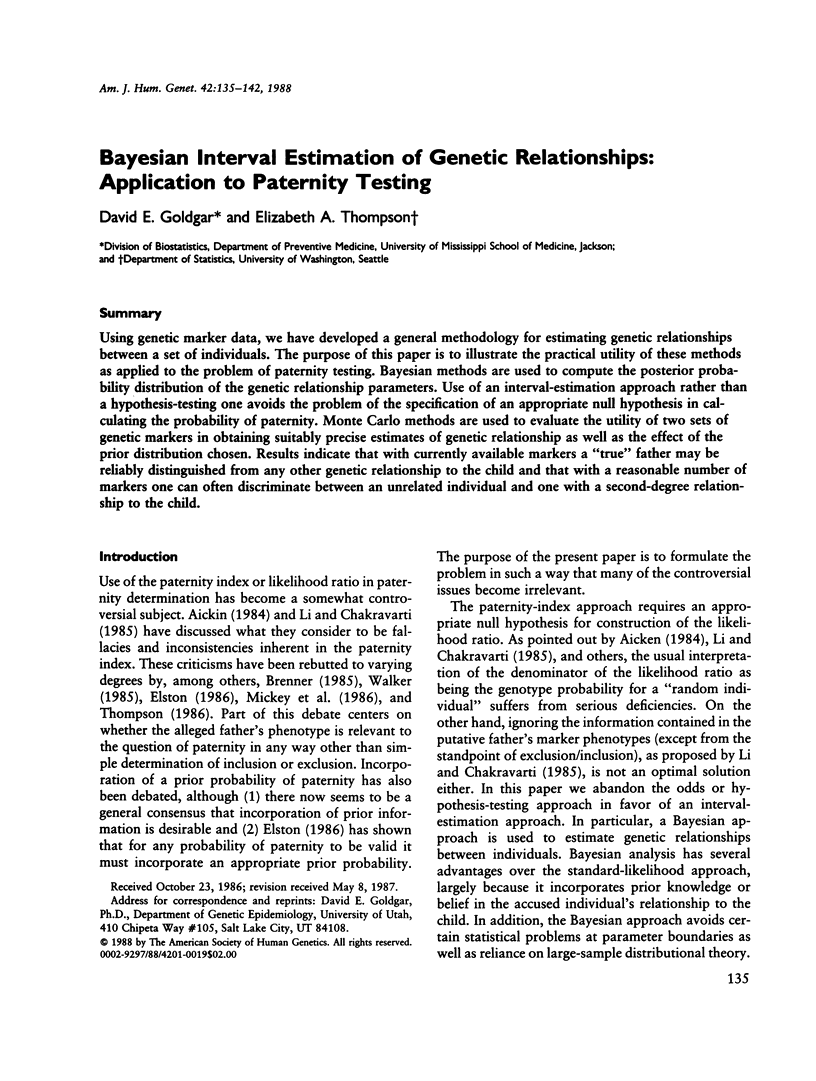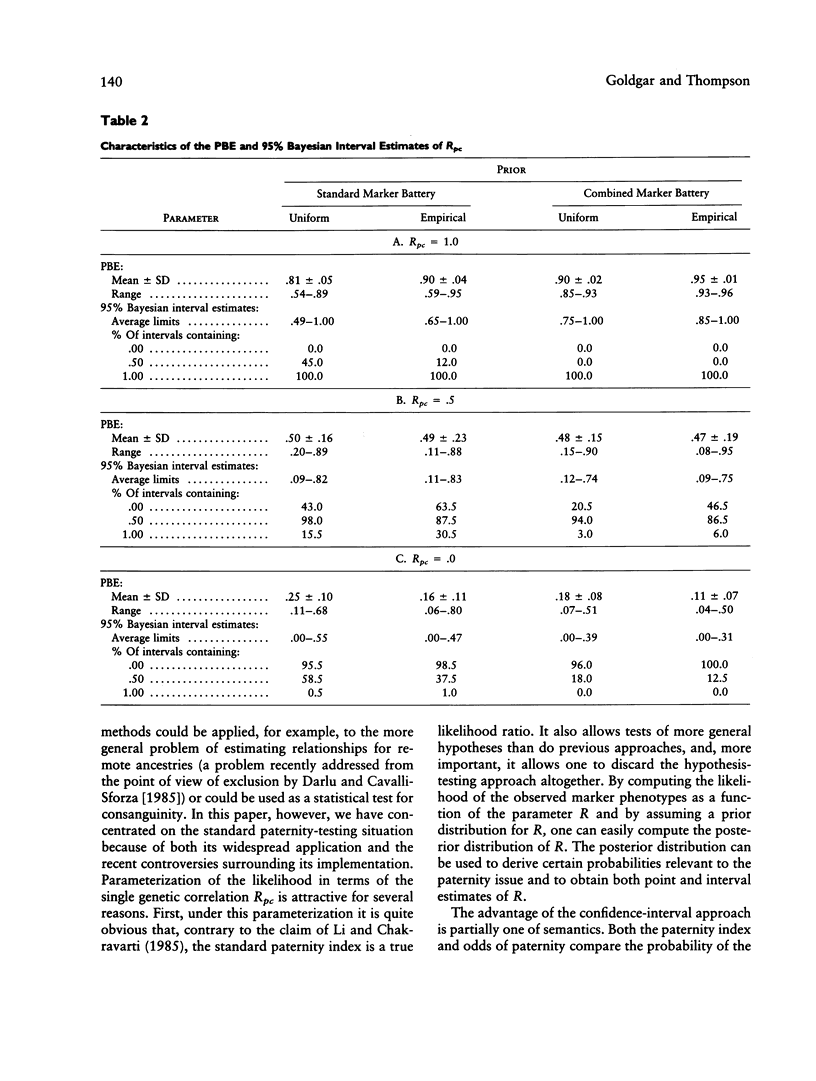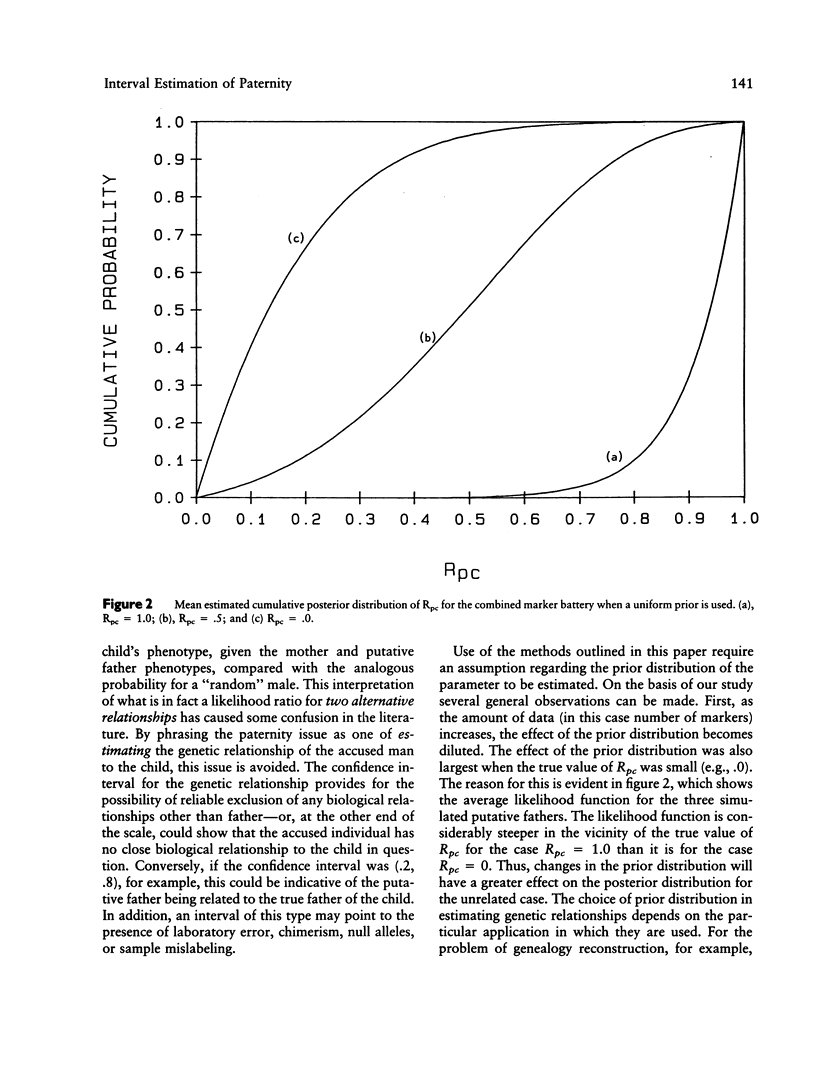Abstract
Using genetic marker data, we have developed a general methodology for estimating genetic relationships between a set of individuals. The purpose of this paper is to illustrate the practical utility of these methods as applied to the problem of paternity testing. Bayesian methods are used to compute the posterior probability distribution of the genetic relationship parameters. Use of an interval-estimation approach rather than a hypothesis-testing one avoids the problem of the specification of an appropriate null hypothesis in calculating the probability of paternity. Monte Carlo methods are used to evaluate the utility of two sets of genetic markers in obtaining suitably precise estimates of genetic relationship as well as the effect of the prior distribution chosen. Results indicate that with currently available markers a "true" father may be reliably distinguished from any other genetic relationship to the child and that with a reasonable number of markers one can often discriminate between an unrelated individual and one with a second-degree relationship to the child.
Full text
PDF







Selected References
These references are in PubMed. This may not be the complete list of references from this article.
- Aickin M. Some fallacies in the computation of paternity probabilities. Am J Hum Genet. 1984 Jul;36(4):904–915. [PMC free article] [PubMed] [Google Scholar]
- Brenner C. H. Evidence, probability, and paternity. Am J Hum Genet. 1985 Jul;37(4):826–827. [PMC free article] [PubMed] [Google Scholar]
- Darlu P., Cavalli-Sforza L. L. The probability of exclusion of ancestries based on genetic observations. Am J Hum Genet. 1985 May;37(3):581–590. [PMC free article] [PubMed] [Google Scholar]
- Elston R. C. Probability and paternity testing. Am J Hum Genet. 1986 Jul;39(1):112–122. [PMC free article] [PubMed] [Google Scholar]
- Jeffreys A. J., Wilson V., Thein S. L., Weatherall D. J., Ponder B. A. DNA "fingerprints" and segregation analysis of multiple markers in human pedigrees. Am J Hum Genet. 1986 Jul;39(1):11–24. [PMC free article] [PubMed] [Google Scholar]
- Kimberling W. J., Goldgar D. E. Utility of genetic markers in the study of human resemblance. Acta Genet Med Gemellol (Roma) 1980;29(4):255–262. doi: 10.1017/s0001566000007765. [DOI] [PubMed] [Google Scholar]
- Li C. C., Chakravarti A. Basic fallacies in the formulation of the paternity index. Am J Hum Genet. 1985 Jul;37(4):809–818. [PMC free article] [PubMed] [Google Scholar]
- Mickey M. R., Gjertson D. W., Terasaki P. I. Empirical validation of the Essen-Möller probability of paternity. Am J Hum Genet. 1986 Jul;39(1):123–132. [PMC free article] [PubMed] [Google Scholar]
- Olson S. B., Magenis R. E., Lovrien E. W. Human chromosome variation: the discriminatory power of Q-band heteromorphism (variant) analysis in distinguishing between individuals, with specific application to cases of questionable paternity. Am J Hum Genet. 1986 Feb;38(2):235–252. [PMC free article] [PubMed] [Google Scholar]
- Smouse P. E., Chakraborty R. The use of restriction fragment length polymorphisms in paternity analysis. Am J Hum Genet. 1986 Jun;38(6):918–939. [PMC free article] [PubMed] [Google Scholar]
- Thompson E. A. Gene identities and multiple relationships. Biometrics. 1974 Dec;30(4):667–680. [PubMed] [Google Scholar]
- Walker R. H. Guidelines for reporting estimates of probability of paternity. Am J Hum Genet. 1985 Jul;37(4):819–827. [PMC free article] [PubMed] [Google Scholar]
- Yasuda N. Estimation of the inbreeding coefficient from phenotype frequencies by a method of maximum likelihood scoring. Biometrics. 1968 Dec;24(4):915–935. [PubMed] [Google Scholar]


